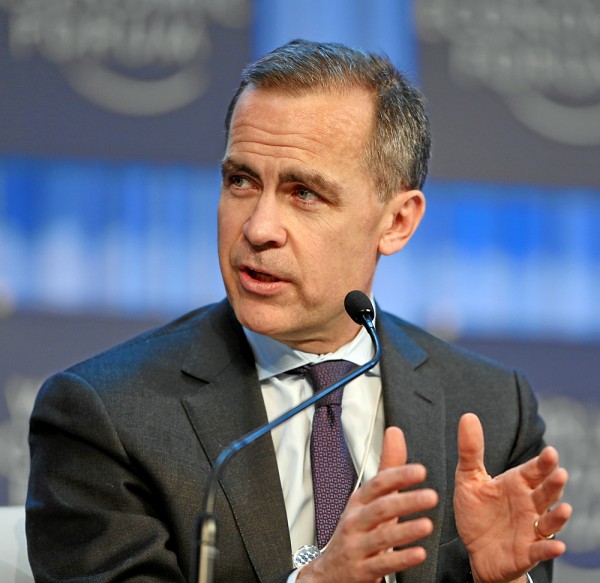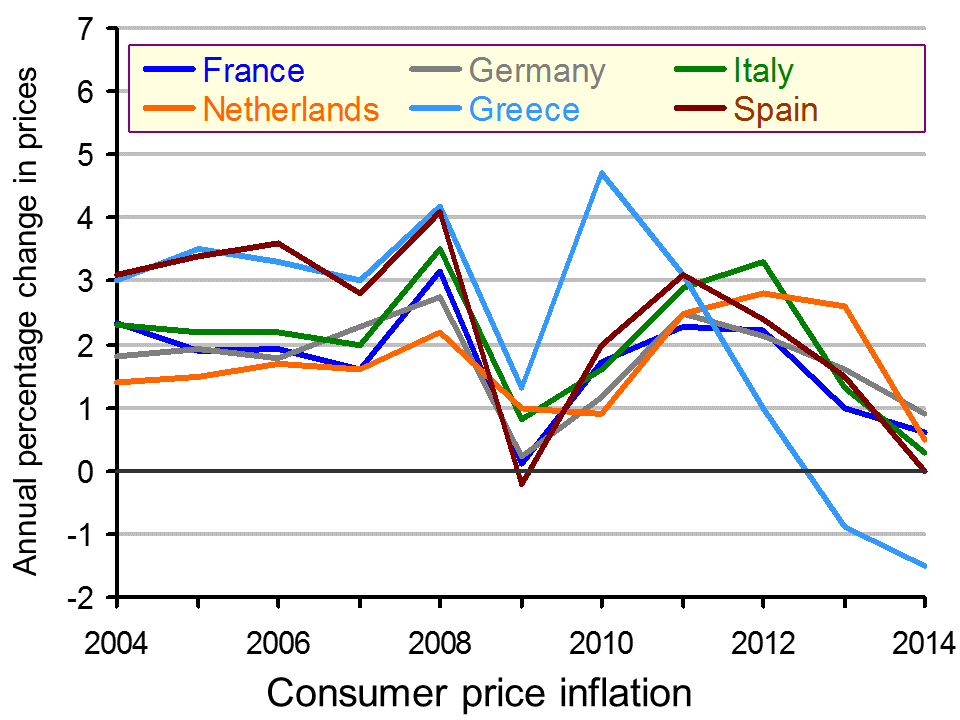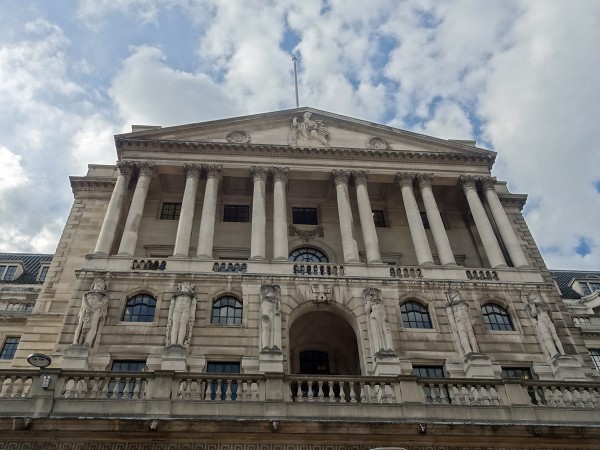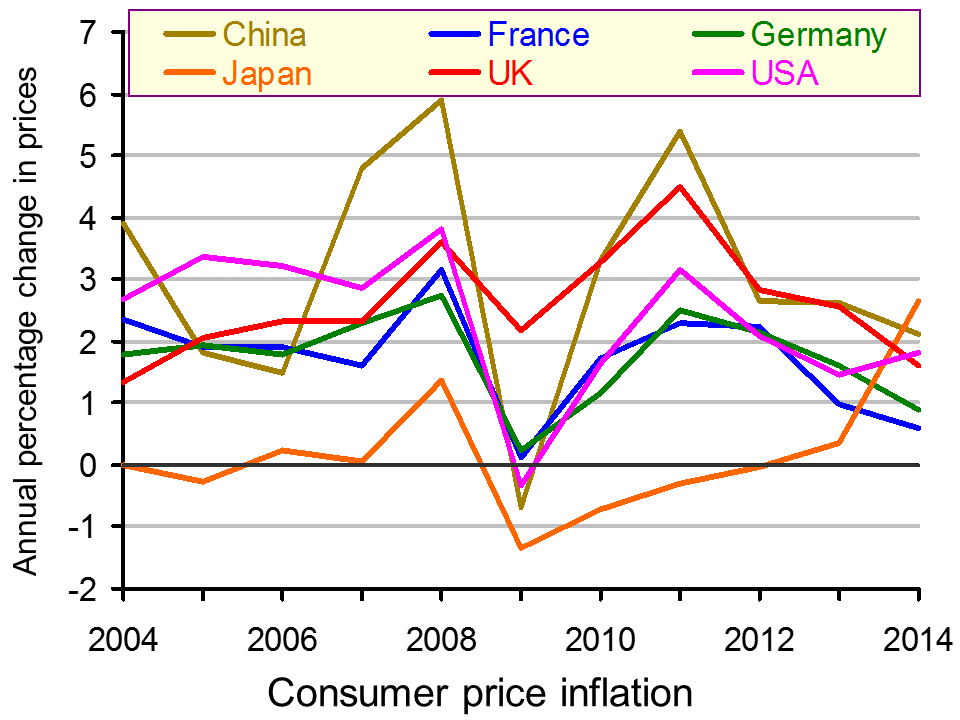 In a speech in Dublin on 28 January 2015, titled ‘Fortune favours the bold‘, Mark Carney, the Governor of the Bank of England, compared the UK economy to that of the 19-nation eurozone. While he welcomed the ECB’s recently announced quantitative easing programme, he argued that the current construction of the eurozone is unfinished and still has two fundamental weaknesses that have not been addressed.
In a speech in Dublin on 28 January 2015, titled ‘Fortune favours the bold‘, Mark Carney, the Governor of the Bank of England, compared the UK economy to that of the 19-nation eurozone. While he welcomed the ECB’s recently announced quantitative easing programme, he argued that the current construction of the eurozone is unfinished and still has two fundamental weaknesses that have not been addressed.
The first is the fragmented nature of banking:
With limited cross-border banking in the euro area, savings don’t flow to potential investments. Euro-area corporates’ cash balances have risen to the tune of €420 billion, or 3% of GDP, since the crisis, for example. Modest cross-border equity flows mean inadequate risk sharing.
The second is the lack of an integrated fiscal policy.
For complete solutions to both current and potential future problems, the sharing of fiscal risks is required.
It is no coincidence that effective currency unions tend to have centralised fiscal authorities whose spending is a sizeable share of GDP – averaging over a quarter of GDP for advanced countries outside the euro area.
… If the eurozone were a country, fiscal policy would be substantially more supportive. However, it is tighter than in the UK, even though Europe still lacks other effective risk sharing mechanisms and is relatively inflexible. A more constructive fiscal policy would help recycle surplus private savings and mitigate the tail risk of stagnation. It would also bridge the drag from structural reforms on nominal spending and would be consistent with the longer term direction of travel towards greater integration.
and is relatively inflexible. A more constructive fiscal policy would help recycle surplus private savings and mitigate the tail risk of stagnation. It would also bridge the drag from structural reforms on nominal spending and would be consistent with the longer term direction of travel towards greater integration.
But fiscal integration requires a political will to transfer fiscal surpluses from the stronger countries, such as Germany, to the weaker countries, such as those in southern Europe.
Overall, the financial and fiscal position in the eurozone is strong:
Gross general government debt in the euro area is roughly the same as in the UK and below the average of advanced economies. The weighted average yield on 10-year euro area sovereign debt is around 1%, compared to 1½% in the UK. And yet, the euro area’s fiscal deficit is half that in the UK. Its structural deficit, according to the IMF, is less than one third as large.
But, unlike the UK, where, despite the rhetoric of austerity, automatic fiscal stabilisers have been allowed to work and the government has accepted a much slower than planned reduction in the deficit, in the eurozone fiscal policy remains tight. Yet unemployment, at 11½%, is twice the rate in the UK and economic growth, at around 0.7% is only one-quarter of that in the UK.
Without a eurozone-wide fiscal policy the problem of slow growth is likely to persist for some time. Monetary policy in the form of QE will help and structural reforms will help to stimulate potential output and long-term growth, but these policies could be much more effective if backed up by fiscal policy.
Whether they will be any time soon is a political question.
Speech
Fortune favours the bold Bank of England. Mark Carney (29/1/15)
Articles
Bank of England’s Carney urges Europe to take plunge on fiscal union Reuters, Padraic Halpin (28/1/15)
Bank Of England’s Mark Carney Attacks ‘Timid’ Eurozone Recovery Attempts Huffington Post, Jack Sommers (29/1/15)
BoE’s Mark Carney calls for common eurozone fiscal policies Financial Times, Ferdinando Giugliano (28/1/15)
Carney attacks German austerity BBC News, Robert Peston (28/1/15)
Bank of England governor attacks eurozone austerity The Guardian, Larry Elliott (28/1/15)
Questions
- Compare the financial and fiscal positions of the UK and the eurozone.
- In what way is there a ‘debt trap’ in the eurozone?
- What did Mark Carney mean when he said, ‘Cross-border risk-sharing through the financial system has slid backwards.’?
- What options are there for the eurozone sharing fiscal risks?
- What would a ‘more constructive’ fiscal policy, as advocated by Mark Carney, look like?
- How do the fiscal policies of other currency unions, such as the UK (union of the four nations of the UK) or the USA (union of the 50 states) or Canada (union of the 10 provinces and three territories), differ from that of the eurozone?
 After promises made back in July 2012 that the ECB will ‘do whatever it takes’ to protect the eurozone economy, the ECB has at last done just that. It has launched a large-scale quantitative easing programme. It will create new money to buy €60 billion of assets every month in the secondary market.
After promises made back in July 2012 that the ECB will ‘do whatever it takes’ to protect the eurozone economy, the ECB has at last done just that. It has launched a large-scale quantitative easing programme. It will create new money to buy €60 billion of assets every month in the secondary market.
Around €10 billion will be private-sector securities that are currently being purchased under the asset-backed securities purchase programme (ABSPP) and the covered bond purchase programme (CBPP3), which were both launched late last year. The remaining €50 billion will be public-sector assets, mainly bonds of governments in the eurozone. This extended programme of asset purchases will begin in March this year and continue until at least September 2016, bringing the total of asset purchased by that time to over €1.1 trillion.
The ECB has taken several steps towards full QE over the past few months, including €400 billion of targeted long-term lending to banks, cutting interest rates to virtually zero (and below zero for the deposit rate) and the outright purchase of private-sector assets. But all these previous moves failed to convince markets that they would be enough to stimulate recovery and stave off deflation. Hence the calls for full quantitative easing became louder and it was widely anticipated that the ECB would finally embark on the purchase of government bonds – in other words, would finally adopt a programme of QE similar to those adopted in the USA (from 2008), the UK (from 2009) and Japan (from 2010).
Rather than the ECB buying the government bonds centrally, each of the 19 national central banks (NCBs), which together with the ECB constitute the Eurosystem, will buy their own nation’s bonds.  The amount they will buy will depend on their capital subscriptions the eurozone. For example, the German central bank will buy German bonds amounting to 25.6% of the total bonds purchased by national central banks. France’s share will be 20.1% (i.e. French bonds constituting 20.1% of the total), Spain’s share will be 12.6% and Malta’s just 0.09%.
The amount they will buy will depend on their capital subscriptions the eurozone. For example, the German central bank will buy German bonds amounting to 25.6% of the total bonds purchased by national central banks. France’s share will be 20.1% (i.e. French bonds constituting 20.1% of the total), Spain’s share will be 12.6% and Malta’s just 0.09%.
Central banks of countries that are still in bail-out programmes will not be eligible to purchase their countries’ assets while their compliance with the terms of the bailout is under review (as is the case currently with Greece).
The risk of government default on their bonds will be largely (80%) covered by the individual countries’ central banks, not by the central banks collectively. Only 20% of bond purchases will be subject to risk sharing between member states according to their capital subscription percentages: the ECB will directly purchase 8% of government bonds and 12% will be bonds issued by European institutions rather than countries. As the ECB explains it:
With regard to the sharing of hypothetical losses, the Governing Council decided that purchases of securities of European institutions (which will be 12% of the additional asset purchases, and which will be purchased by NCBs) will be subject to loss sharing. The rest of the NCBs’ additional asset purchases will not be subject to loss sharing. The ECB will hold 8% of the additional asset purchases. This implies that 20% of the additional asset purchases will be subject to a regime of risk sharing.
As with the QE programmes in the USA, the UK and Japan, the transmission mechanism is indirect. The assets purchased will be from financial institutions, who will thus receive the new money. The bond purchases and the purchases of assets by financial institutions with the acquired new money will drive up asset prices and hence drive down long-term interest rates. This, hopefully, will stimulate borrowing and increase aggregate demand and hence output, employment and prices.
The ECB will buy bonds issued by euro area central governments, agencies and European institutions in the secondary market against central bank money, which the institutions that sold the securities can use to buy other assets and extend credit to the real economy. In both cases, this contributes to an easing of financial conditions.
In addition, there is an exchange rate transmission mechanism. To the extent that the extra money is used to purchase non-eurozone assets, so this will drive down the euro exchange rate. This, in turn, will boost the demand for eurozone exports and reduce the demand for imports to the eurozone. This, again, represents an increase in aggregate demand.
The extent to which people will borrow more depends, of course, on confidence that the eurozone economy will expand. So far, the response of markets suggests that such confidence will be there. But we shall have to wait to see if the confidence is sustained.
But even if QE does succeed in stimulating aggregate demand, there remains the question of the competitiveness of eurozone economies. Some people are worried, especially in Germany, that the boost given by QE will reduce the pressure on countries to engage in structural reforms – reforms that some people feel are vital for long-term growth in the eurozone
The articles consider the responses to QE and assess its likely impact.
Articles
ECB publications
Previous blog posts
Data
Questions
- Why has the ECB been reluctant to engage in full QE before now?
- How has the ECB answered the objections of strong eurozone countries, such as Germany, to taking on the risks associated with weaker countries?
- What determines the amount by which aggregate demand will rise following a programme of asset purchases?
- In what ways and to what extent will non-eurozone countries benefit or lose from the ECB’s decision?
- Are there any long-term dangers to the eurozone economy of the ECB’s QE programme? If so, how might they be tackled?
- Why did the euro plummet on the ECB’s announcement? Why had it not plummeted before the announcement, given that the introduction of full QE was widely expected?
 The eurozone is certainly in trouble and, despite the efforts of world leaders to create confidence, it appears that most announcements are having the opposite effect. The risk of deflation has now emerged to be very true; the powerhouse of Europe ‘needs to do more’ and the euro has fallen following Mario Draghi’s recent comments. So, just how bad are things in the eurozone?
The eurozone is certainly in trouble and, despite the efforts of world leaders to create confidence, it appears that most announcements are having the opposite effect. The risk of deflation has now emerged to be very true; the powerhouse of Europe ‘needs to do more’ and the euro has fallen following Mario Draghi’s recent comments. So, just how bad are things in the eurozone?
Mario Draghi suggested that as a means of stimulating the eurozone economies, a process of quantitative easing may soon need to begin. However, rather than reassuring investors that action was being taken to improve the economic performance in the region, it appears to have had the opposite effect. Following his comments, the euro fell to its lowest level since the middle of 2010.
Quantitative easing has seen much use in the aftermath of the financial crisis and the aim in the eurozone would be to put a stop to the continuing price decreases. The eurozone has now entered deflation and, while the aim of this economic area has always been low prices, deflation is not good news. The downward pressure on prices has been largely driven by oil prices falling and prices in other areas remaining relatively stable.
Quantitative easing would inject money into the eurozone, thus creating growth (or at least that’s the idea) and pushing up prices. One of Mario Draghi’s comments was:
‘We are making technical preparations to alter the size, pace and composition of our measures in early 2015.’
 So, while it’s not certain that the QE policy will be used, it seems pretty likely, especially as this policy has been floating around for almost a year.
So, while it’s not certain that the QE policy will be used, it seems pretty likely, especially as this policy has been floating around for almost a year.
A key question is, will it work? The quantity theory of money does suggest that an increase in the money supply will lead to inflationary pressures, unless its velocity of circulation falls. But will it actually stimulate aggregate demand and economic growth? If there is more money in the banking system and hence more money available for lending then it may well stimulate investment and consumption. However, if consumers and firms are not confident about the effectiveness of the policy or about the future of the economy, then will the fact that more money is available for lending actually encourage them to borrow? In this case will there merely be a fall in the velocity of circulation?
The comments by Mario Draghi have also caused the euro to fall to its lowest level since 2010. The graph included in the CNBC article provides an interesting view of the path of the euro. Marc Chandler, from Brown Brothers Harriman said:
‘I’d say there’s a good chance it [the euro] gets there [parity with the dollar] before the election next November (2016) … We know the Fed’s going to be raising rates sooner or later, and the ECB is going to be easing sooner or later. I just see a steady grind lower.’
The outlook of the euro therefore doesn’t look too good by all accounts. It is now a waiting game to see if the policy of quantitative easing is implemented and whether or not it has the desired effect. The following articles consider this topic.
Eurozone economy slows further BBC News (6/1/15)
Eurozone falls into deflation for first time since October 2009 Financial Times, Claire Jones (7/1/15)
Eurozone officially falls into deflation, piling pressure on ECB The Telegraph, Marion Dakers (7/1/15)
Eurozone consumer prices fall for first time in five years Nasdaq, Brian Blackstone and Paul Hannon (7/1/15)
Draghi comments send euro to lowest level since 2010 BBC News (2/1/15)
Oil slump drags Eurozone into deflation The Guardian, Graeme Wearden (7/1/15)
Eurozone prices fall more than expected in December Reuters (7/1/15)
Eurozone lurches into deflation after oil price crashes Independent, Russell Lynch (7/1/15)
German inflation hits five-year low as Eurozone prepares for QE The Telegraph, Mehreen Khan (5/1/15)
Euro slide could take it to parity with dollar CNBC, Patti Domm (7/1/15)
Questions
- Why is deflation a cause for concern when normally the main problem is inflation that is too high?
- What is the quantity theory of money and how does it suggest an increase in the money supply will affect prices?
- If quantitative easing is implemented, is it likely to have the desired effect? Explain why or why not.
- Why has the euro been affected by Mario Draghi’s comments? Use a diagram to help your explanation.
- How will quantitative easing help to stimulate economic growth across the Eurozone? Are there any other policies that would be effective?
- Oil prices have had a big influence on the deflationary pressures in the Eurozone. If oil prices increased again, would this be sufficient to create inflation?
 The eurozone is made up of 18 countries (19 in January) and, besides sharing a common currency, they also seem to be sharing the trait of weak economic performance. The key macroeconomic variables across the eurozone nations have all seemingly been moving in the wrong direction and this is causing a lot of concern for policy-makers.
The eurozone is made up of 18 countries (19 in January) and, besides sharing a common currency, they also seem to be sharing the trait of weak economic performance. The key macroeconomic variables across the eurozone nations have all seemingly been moving in the wrong direction and this is causing a lot of concern for policy-makers.
Some of the biggest players in the eurozone have seen economic growth on the down-turn, unemployment rising and consumer and business confidence falling once again. Germany’s economic growth has been revised down and in Italy, unemployment rose to a record of 13.2% in September and around 25% of the workforce remains out of work in Spain and Greece. A significant consequence of the sluggish growth across this 18-nation bloc of countries is the growing risk of deflation.
 Whilst low and stable inflation is a macroeconomic objective across nations, there is such a thing as inflation that is too low. When inflation approaches 0%, the spectre of deflation looms large (see the blog post Deflation danger). The problem of deflation is that when people expect prices to fall, they stop spending. As such, consumption falls and this puts downward pressure on aggregate demand. After all, if you think prices will be lower next week, then you are likely to wait until next week. This decision by consumers will cause aggregate demand to shift to the left, thus pushing national income down, creating higher unemployment. If this expectation continues, then so will the inward shifts in AD. This is the problem facing the eurozone. In November, the inflation rate fell to 0.3%. One of the key causes is falling energy prices – normally good news, but not if inflation is already too low.
Whilst low and stable inflation is a macroeconomic objective across nations, there is such a thing as inflation that is too low. When inflation approaches 0%, the spectre of deflation looms large (see the blog post Deflation danger). The problem of deflation is that when people expect prices to fall, they stop spending. As such, consumption falls and this puts downward pressure on aggregate demand. After all, if you think prices will be lower next week, then you are likely to wait until next week. This decision by consumers will cause aggregate demand to shift to the left, thus pushing national income down, creating higher unemployment. If this expectation continues, then so will the inward shifts in AD. This is the problem facing the eurozone. In November, the inflation rate fell to 0.3%. One of the key causes is falling energy prices – normally good news, but not if inflation is already too low.
 Jonathan Loynes, Chief European Economist at Capital Economics said:
Jonathan Loynes, Chief European Economist at Capital Economics said:
“[the inflation and jobless data] gives the ECB yet another nudge to take urgent further action to revive the recovery and tackle the threat of deflation…We now expect the headline inflation rate to drop below zero at least briefly over the next six months and there is a clear danger of a more prolonged bout of falling prices.”
Some may see the lower prices as a positive change, with less household income being needed to buy the same basket of goods. However, the key question will be whether such low prices are seen as a temporary change or an indication of a longer-term trend. The answer to the question will have a significant effect on business decisions about investment and on the next steps to be taken by the ECB. It also has big consequences for other countries, in particular the UK. The data over the coming months across a range of macroeconomic variables may tell us a lot about what is to come throughout 2015. The following articles consider the eurozone data.
Euro area annual inflation down to 0.3% EuroStat News Release (28/11/14)
Eurozone inflation weakens again, adding pressure on ECB Nasdaq, Brian Blackstone (28/11/14)
Eurozone inflation rate falls in October BBC News (28/11/14)
Eurozone recovery fears weigh on UK plc, says report Financial Times, Alison Smith (30/11/14)
€300bn Jean-Claude Juncker Eurozone kickstarter sounds too good to be true The Guardian, Larry Elliott (26/11/14)
Eurozone area may be in ‘persistent stagnation trap’ says OECD BBC News (25/11/14)
Euro area ‘major risk to world growth’: OECD CNBC, Katy Barnato (25/11/14)
OECD sees gradual world recovery, urges ECB to do more Reuters, Ingrid Melander (25/11/14)
Questions
- What is deflation and why is it such a concern?
- Illustrate the impact of falling consumer demand in an AD/AS diagram.
- What policies are available to the ECB to tackle the problem of deflation? How successful are they likely to be and which factors will determine this?
- To what extent is the economic stagnation in the Eurozone a cause for concern to countries such as the UK and US? Explain your answer.
- How effective would quantitative easing be in combating the problem of deflation?
 The articles linked below look at the dangers of deflation and policies of central banks to counter it.
The articles linked below look at the dangers of deflation and policies of central banks to counter it.
Deflation in economics has three meanings. The first is falling prices: i.e. negative inflation. The second, more traditional meaning, is a fall in real aggregate demand, resulting in lower output, higher unemployment and lower inflation – and quite possibly an actual fall in the price level. These first two definitions describe what is generally seen as an undesirable situation. The third is a slowing down in the growth of real aggregate demand, perhaps as a result of a deliberate act of fiscal and/or monetary policy. This third meaning could describe a desirable situation, where unsustainable growth is reduced and inflation is reduced from an above-target level.
Here we focus on the first definition. The first two articles look at the dangers of a fall in the price level. The chart below shows falling inflation, although not actually deflation, in China, France, Germany and the UK (click here for a PowerPoint). Several European countries, however, are experiencing actual deflation. These include: Greece, Spain, Hungary, Poland and Sweden. Inflation in the eurozone for 2014 is expected to be a mere 0.5%.
The most obvious danger of deflation (or expected deflation) is that people will delay spending on durable goods, such as cars, furniture and equipment, hoping to buy the items cheaper later.  The result could be a fall in aggregate demand and a fall in output and employment.
The result could be a fall in aggregate demand and a fall in output and employment.
For retailers, this is all spelling Christmas doom. Already the runup to the most crucial time of the year for shops is being characterised by a game of chicken. Shoppers are wondering how long they can leave their festive buying in the hope of late bargains.
Interest rates may be low, but for people with debts, this is being offset by the fact that inflation is no longer reducing the real value of that debt. For people with credit card debt, personal loans and most mortgages, the interest rate they pay is significantly above the rate of inflation. In other words, the real interest rate on their debt is still significantly positive. This may well discourage people from borrowing and spending, further dampening aggregate demand. And, with a Bank Rate of just 0.5%, there is virtually no scope for lowering the official interest rate further.
At least in the UK, economic growth is now positive – for the time being at any rate. The danger is becoming more serious, however, in many eurozone countries, which are already back in recession or close to being so. The ECB, despite its tentative steps to ease credit conditions, it moving closer to the day when it announces full-blown quantitative easing and buys sovereign bonds of eurozone countries. The Bank of Japan has already announced that it is stepping up it QE programme – a vital ingredient in getting Abenomics back on track and pulling Japan out of its latest recession.
In the USA, by contrast, there is little danger of deflation, as the US economy continues to grow strongly. The downside of this, has been a large rise in consumer debt (but not mortgages) – the ingredients of a possible future bubble and even a new financial crisis.
Forget what central bankers say: deflation is the real monster The Observer, Katie Allen (23/11/14)
Why Deflation Is Such A Big Worry For Europe NPR, Jim Zarroli (31/10/14)
Exclusive: China ready to cut rates again on fears of deflation – sources Reuters, Kevin Yao (23/11/14)
Central Banks in New Push to Prime Pump Wall Street Journal Jon Hilsenrath, Brian Blackstone and Lingling Wei (21/11/14)
Are Central Banks Panicking? Seeking Alpha, Leo Kolivakis (21/11/14)
Questions
- What are (a) the desirable and (b) the undesirable consequences of deflation? Does the answer depend on how deflation is defined?
- What is meant by a ‘deflationary gap’? In what sense is ‘deflationary’ being used in this term?
- Why have oil prices been falling? How desirable are these falls for the global economy?
- Is there an optimal rate of inflation? If so, how would this rate be determined?
- The chart shows that inflation in Japan is likely to have risen in 2014. This in large part is the result to a rise in the sales tax earlier this year. If there is no further rise in the sales tax, which there will probably not be if Mr Abe’s party wins the recently called election, what is likely to be the effect of the 2014 tax rise on inflation in 2015?
- If the Bank Rate is below the rate of inflation, why are people facing a positive real rate of interest? Does this apply equally to borrowers and savers?
- In what sense is there a cultural revolution at the Bank of England?
 In a speech in Dublin on 28 January 2015, titled ‘Fortune favours the bold‘, Mark Carney, the Governor of the Bank of England, compared the UK economy to that of the 19-nation eurozone. While he welcomed the ECB’s recently announced quantitative easing programme, he argued that the current construction of the eurozone is unfinished and still has two fundamental weaknesses that have not been addressed.
In a speech in Dublin on 28 January 2015, titled ‘Fortune favours the bold‘, Mark Carney, the Governor of the Bank of England, compared the UK economy to that of the 19-nation eurozone. While he welcomed the ECB’s recently announced quantitative easing programme, he argued that the current construction of the eurozone is unfinished and still has two fundamental weaknesses that have not been addressed.and is relatively inflexible. A more constructive fiscal policy would help recycle surplus private savings and mitigate the tail risk of stagnation. It would also bridge the drag from structural reforms on nominal spending and would be consistent with the longer term direction of travel towards greater integration.






